The Monument is … well … a monument. Specifically, it is a monument to the Great Fire of London of 1666 and the rebuilding of the city. It is a Doric-style stone pillar, 202 feet tall, situated 202 feet away from Pudding Lane where the Great Fire started.
 |
| The Monument, London |
The Great Fire of London
The Great Fire of London raged from 2-5 September 1666. The fire started at the house of the king’s baker in Pudding Lane and the wind caused it to spread rapidly. While it raged, the fire destroyed thousands of houses and more than 80 churches, including St Paul’s Cathedral. Very few lives were lost, but a large area of the city was burnt down.
A monument to the Great Fire
An Act of Parliament was passed for rebuilding the City of London and it decreed:
That a Columne or Pillar of Brase or Stone be erected on or as neere unto the place where the said Fire soe unhappily began as conveniently may be, in perpetuall Remembrance thereof.1
Sir Christopher Wren, Surveyor General to Charles II, designed the obligatory commemorative pillar in conjunction with his colleague, Dr Robert Hooke. Wren also designed many churches that were rebuilt after the fire, including, most famously, St Paul’s Cathedral. The existing design was agreed upon after plans for a pillar surmounted with a phoenix or a statue of the king were dismissed as too costly and unsuitable.
The resulting memorial was a Doric column made of Portland stone supporting a drum and a copper urn containing flames representing the Great Fire. It was built in 1671-7 on the site of St Margaret’s Church, off Fish Street Hill, the first church to be destroyed by the fire. Inside the Monument is a cantilevered stone staircase which leads to a viewing platform, 160 feet above street level.
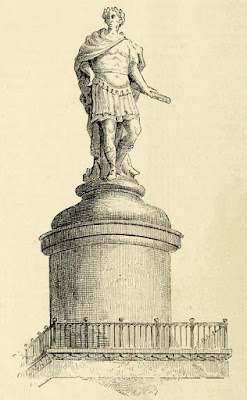 |
| One of Wren's rejected designs for the top of the Monument from Old and New London by W Thornbury (1873) |
The inscription on the north side of the pedestal states that the total height of the Monument of 202 feet is equal to the distance eastward to the house in Pudding Lane where the fire broke out.
In his history, Welch described the Monument as the ‘finest isolated stone column in the world.’2
 |
| The Monument, London |
A Georgian tourist attraction
Feltham’s Picture of London for 1810 described the Monument:
THE MONUMENTAbout 20 yards north of London-bridge is situated the finest pillar in the world, erected by Sir Christopher Wren, in memory of the great fire, which, in 1666, broke out at a house on this spot, and destroyed the metropolis, from the Tower to Temple Bar.It is a fluted column, of the Doric order: the total height of it is 202 feet; the diameter at the base 15 feet, and the height of the column 120 feet. The height of the massy pedestal is 40 feet, and the cone at the top, with its urn, is 42 feet. Within the column is a flight of 345 steps, and from the iron balcony at top is a most fascinating prospect of the metropolis, and the adjacent country. The admittance to the top is sixpence. It is impossible not to lament the obscure situation of this beautiful monument, which in a proper place would form one of the most striking objects of the kind that architecture is capable of producing.3
 |
| The Monument 1809 from History of the Monument by C Welch (1893) |
The column occupies the spot where formerly stood the parish church of St Margaret. It was begun in 1671, and completed in 1677. On the north and south sides of the pedestal are inscriptions in English and Latin, descriptive of the conflagration which consumed the city, and of its subsequent restoration. On the west side is an emblematical group of sculpture in alto and basso relievo executed by Caius Gabriel Cibber, representing Time raising London, (which is personified by a female figure, reclining on the ruins of the city,) under the fostering patronage of Charles II and his brother, the Duke of York, who are attended by three females representing Imagination, Ichnographia, and Liberty. Below the king is Envy, blowing flames from her mouth, and behind him, Mars and Fortitude. In the background, on the left, is the city in flames, and on the right, are labourers erecting new buildings. A short inscription in English goes round the pedestal, ascribing the conflagration to the treachery and malice of a popish faction. This immense column, which far exceeds in altitude the celebrated pillars of Trajan and Antoninus at Rome, contains upwards of 28,000 feet of solid Portland stone.4
 |
| The Monument, London |
The anti-Catholic inscription
The short inscription blaming the Catholics for starting the Great Fire of London was added in 1681 as a result of the anti-Catholic feeling engendered by Titus Oates and the Popish Plot.
The Picture of London for 1810 dismissed this as ridiculous:
No rational being can entertain the notion, that the catholics, or any religious sect, could wilfully have perpetrated so horrible a deed as this pillar was intended to impute to them, nor can so much credit be given to human foresight, as for it to be concluded that a fire, which broke out in a single house, could upon this, rather than upon other occasions, have extended its ravages in so extraordinary a manner.5
Crosby’s guide agreed:
The inscription on the pedestal, imputing the calamity to the Papists, is now universally considered as unjust.6
The objectional lines were removed by order of the Court of Common Council dated 6 December 1830.
How many steps?
 |
| The Monument staircase from above |
Within is a large staircase of black marble, containing 345 steps 10½ inches broad and 6 inches risers.7
The Georgian guidebooks and Welch’s History of the Monument concur that there were 345 steps. I am perplexed as to what has happened to the other 34 steps. Has the staircase been rebuilt at some stage? Is the viewing platform lower now than it once was? I have been unable to find anything that explains why the number varies so greatly. Can anyone solve the mystery for me?
A scientific laboratory
 |
| The Monument staircase from below from History of the Monument by C Welch (1893) |
 |
| The Monument staircase from below |
Old and New London wrote that the Monument
… was at first used by the members of the Royal Society for astronomical purposes, but was abandoned on account of its vibration being too great for the nicety required in their observations.8
A daring descent
The Original Picture of London (1829) wrote:
In September 1732, a sailor slid down a rope stretched from the gallery of the Monument to the Three Tuns Tavern in Gracechurch Street; and on the following day, a waterman's boy descended by the same rope into the street.9
Old and New London wrote:
On June 15, 1825, the Monument was illuminated with portable gas, in commemoration of laying the first stone of New London Bridge. A lamp was placed at each of the loop-holes of the column, to give the idea of its being wreathed with flame; whilst two other series were placed on the edges of the gallery, to which the public were admitted during the evening.10
On 18 November 1852, four artillery men of the Royal Artillery were stationed on the Monument in order to pass signals from St Paul’s Cathedral to the Tower on the occasion of the funeral of the Duke of Wellington.
The introduction of the cage
In 1750, a dreadful accident occurred. A weaver named William Green leaned too far over the railings of the balcony to look at an eagle which was kept in a cage there and fell over the edge to his death.
During the years 1788 to 1842, six people committed suicide from the Monument, including Lyon Levi, a Jewish diamond merchant, on 18 January 1810. To prevent further tragedy, the building was temporarily closed in August 1842, and before it reopened, the gallery was enclosed with an iron cage.
 |
| The balcony or cage from History of the Monument by C Welch (1893) |
The Monument has been renovated approximately every 100 years with the latest comprehensive restoration programme taking place in 2007-9. The stonework was cleaned and repaired, the urn re-gilded and a new gallery cage installed.
The Monument today
The Monument is open to visitors all year round except 24-26 December. You may have to wait for entry at busy times as a maximum of 33 people are allowed inside at one time. It is also highly unlikely that you will beat the time of a lad who ran up the Monument and down again in 2 minutes 32 seconds in 1732, for a wager. The stairs can get quite busy with people going up and down and you need to be prepared to stop regularly to allow people to pass. However, this does give you a chance for a breather as you make the long climb. If you succeed in climbing the 311 steps, you will be rewarded with fine views of London from the balcony.
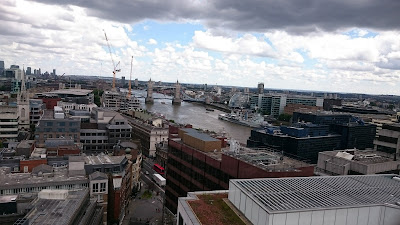 |
| View from the Monument, London (2017) |
Visited August 2017.
Notes
(1) From Welch, Charles, History of The Monument with some account of the great fire of London, which it commemorates (1893).
(2) From Welch, Charles, History of The Monument with some account of the great fire of London, which it commemorates (1893).
(3) From Feltham, John, The Picture of London for 1810 (1810).
(4) From Feltham, John, The Original Picture of London 26th edition (1829).
(5) From Feltham, John, The Original Picture of London 26th edition (1829).
(6) From Crosby, B, A View of London; or the Stranger's Guide through the British Metropolis (Printed for B Crosby, London, 1803-4).
(7) From Thornbury, Walter, Old and New London: A narrative of its history, its people, and its places (Cassell, Petter & Galpin, 1873, London) Vol 1.
(8) From Thornbury, Walter, Old and New London: A narrative of its history, its people, and its places (Cassell, Petter & Galpin, 1873, London) Vol 1.
(9) From Feltham, John, The Original Picture of London 26th edition (1829).
(10) From Thornbury, Walter, Old and New London: A narrative of its history, its people, and its places (Cassell, Petter & Galpin, 1873, London) Vol 1.
Sources used include:
Crosby, B, A View of London; or the Stranger's Guide through the British Metropolis (Printed for B Crosby, London, 1803-4)
Feltham, John, The Original Picture of London 26th edition (1829)
Feltham, John, The Picture of London for 1810 (1810)
Thornbury, Walter, Old and New London: A narrative of its history, its people, and its places (Cassell, Petter & Galpin, 1873, London) Vol 1
Welch, Charles, History of The Monument with some account of the great fire of London, which it commemorates (1893)
All photographs © RegencyHistory.net

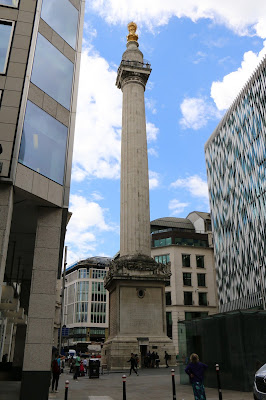
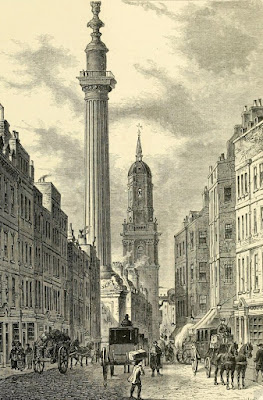




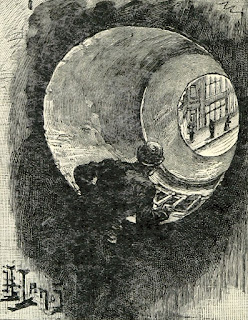


I used to live within walking distance of the Monument, and have climbed it a few times, but never during tourist season.
ReplyDeleteI have never been able to imagine women of the 18th and 19th centuries making it up there in the clothes of the era!
Maybe the incorrect number of steps was just a mistake someone made that spread all over without anyone checking it. As far as I know the number of stairs hasn't changed over the years...
I think it would be impossible to climb up the steps in a crinoline but it might be feasible to climb in a Regency dress as it would be narrow enough. I didn't wear mine to climb the Monument, but I was wearing a maxi dress and I had to lift it to make sure I didn't tread on it. You may be right about the number of steps. The guidebooks tended to use earlier guidebooks as their primary sources and if they once got the number wrong, it would be easy to see how the error persisted.
DeleteI enjoyed this and was delighted to learn more about the history of the monument. I live not too far from it and once, when my children (then age 9 and 10) were being rather noisy and I couldn't bear it an minute longer, I took them to the Monument and we walked up it.
ReplyDeleteThe view from the top was amazing and I rewarded them with an ice cream when we reached the bottom again. I have to report that, for the rest of the day, my children were nice and quiet!
I imagine they were worn out by the exertion! What a lovely story - thanks for sharing.
Delete